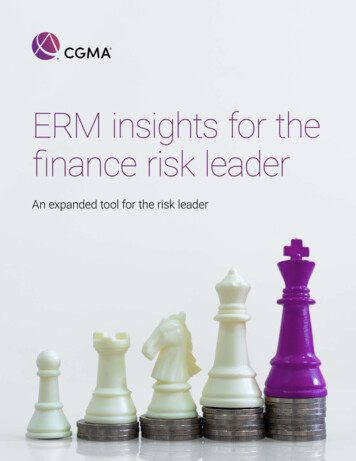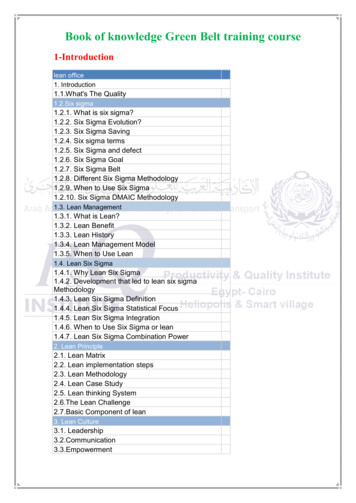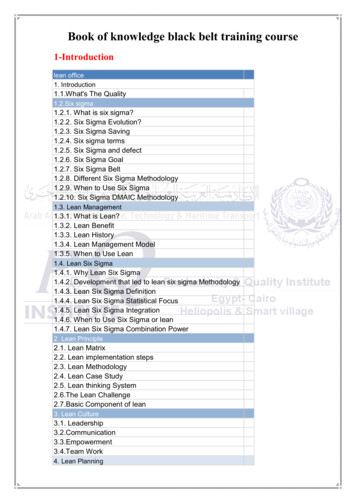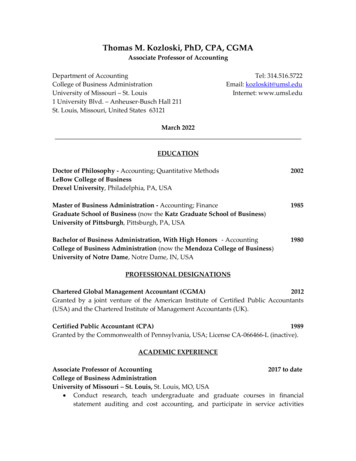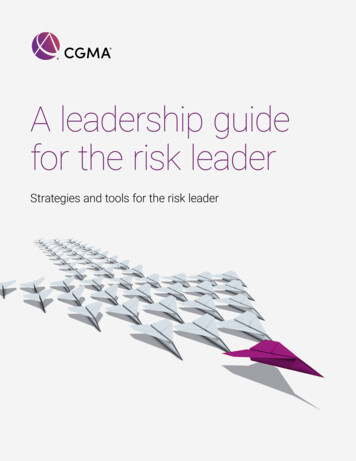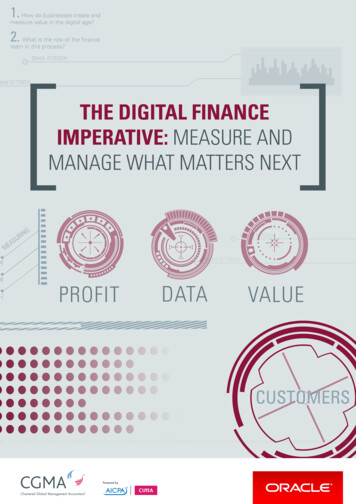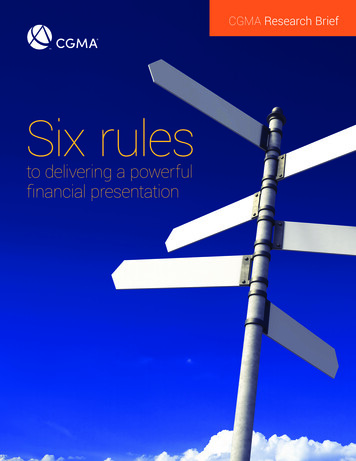
Transcription
CGMA Research BriefSix rulesto delivering a powerfulfinancial presentation
Chartered Global Management Accountant (CGMA ) CGMA is the most widely held management accounting designation in the world. It distinguishesmore than 150,000 accounting and finance professionals who have advanced proficiency in finance,operations, strategy and management. In the U.S., the vast majority are also CPAs. The CGMAdesignation is underpinned by extensive global research to maintain the highest relevance withemployers and develop competencies most in demand. CGMAs qualify through rigorous education,exam and experience requirements. They must commit to lifelong education and adhere to a stringentcode of ethical conduct. Businesses, governments and nonprofits around the world trust CGMAs toguide critical decisions that drive strong performance.cgma.orgAuthorsWe would like to thank Peter A. Margaritis, CPA, CGMA, and Jennifer H. Elder, CPA/CFF, CMA, CIA,CGMA, who contributed their time, knowledge, insight and experience to develop this CGMA resource.Peter A. Margaritis, CPA, CGMA, is an author, blogger, speaker, educator, humorist and podcaster.Partnering with the Business Learning Institute, his firm helps accountants and other businessleaders to increase their profitability by strengthening their business success skills and improvingmorale through better communication. He is a member of the American Institute of CPAs, GeorgiaSociety of CPAs, Maryland Association of CPAs, Ohio Society of CPAs and the National SpeakersAssociation. Peter is the author of Improv Is No Joke: Using Improvisation to Create Positive Results inLeadership and Life. petermargaritis.comJennifer H. Elder, CPA/CFF, CMA, CIA, CGMA, is a speaker, author and executive coach. Her business,The Sustainable CFO, helps executives create long-term success in the future by developing proactivebusiness strategies, professional communication skills and strong ethical values. She has been namedA Woman to Watch’ by the Maryland Association of CPAs and Outstanding Educator by the AICPA.
Contents2Introduction4First rule: It’s all about the audience5Second rule: Let go of the need for perfection6Third rule: Grab the audience’s attention6Fourth rule: Tell the story behind the numbers7Fifth rule: Use pictures to enhance the data8Sixth rule: Simplify10 Conclusion11 Endnotes11 Further reading1
IntroductionWhen delivering a presentation, are you able to keep the audienceengaged and awake? Are you (and your presentation) interestingenough to keep them from looking at their mobile devices? Or is there adanger of being heckled? Bear in mind that heckling can come in manyforms — someone falling asleep is just as much heckling as somebodyinterrupting you. Do you have a fear of standing in front of an audienceand delivering a presentation? Do you worry that you won’t be seen as asubject-matter expert?2
Many people have a fear of public speaking. AsJerry Seinfeld said: “. speaking in front of a crowdis considered the number one fear of the averageperson.” A Forbes survey produced a list of the topnine fears:1. Public speaking2. Crowds3. Bridges4. Enclosed spaces5. Storms6. Public transportation7. Water8. Heights9. Creatures (snakes, insects and rodents)Public speaking was the No. 1 fear, yet the other eightare things that actually could do you harm. Despitethe way many speakers might feel, no one has diedfrom public speaking.The best way to overcome the fear of public speakingis through preparation. The better you prepare,the more confident you will be in delivering yourpresentation. You want to be prepared in such a waythat you feel you’re having a conversation with theaudience, rather than sounding like a robot giving amemorised presentation.Presentations can be boring. Financial presentationsare especially prone to being dull, particularly whensomeone rattles off figure after figure after figure.Think back to your school days: Did you ever have ateacher who read from slides, spoke monotonouslyand put you to sleep in the first five minutes? If youhave seen the movie ”Ferris Bueller’s Day Off,” youprobably remember the scene where Ben Stein playsthe teacher giving a boring lecture on history andnone of the students are paying attention. He asksa question. No one answers, so he says, “anyone,anyone?” and keeps on going. Remember the lookson the students’ faces? Are you in danger of gettingthe same looks?If you want to engage your audience, presentfinancial information with impact and give analtogether great presentation, you’ll need to followthese six rules:1. It’s all about the audience.2. Let go of the need for perfection.3. Grab the audience’s attention.4. Tell the story behind the numbers.5. Use pictures to enhance the data.6. Simplify.Many people will say, “Practice untilyou get it right.” With presentations,practice until you can’t get it wrong.3
First rule: It’s all aboutthe audienceDo you know your audience? Are they accounting,finance and analytical types? Or are they sales andmarketing individuals? Or are they a mixture of both?Let’s begin this discussion with a look at the brain.A brain has two hemispheres, left and right. The lefthemisphere is responsible for language, logic andanalytical thinking. That’s the side that drives theaccounting and finance people. The right hemisphereis responsible for holistic thought, intuition andcreativity. It likes the big picture, not the detail. That’sthe side favoured by the sales and marketing people.Why is this important? Because when you’redelivering financial information to holistic thinkers,their tendency is to avoid detail in numbers. Forthem, focusing on the trees makes it hard to see thebig picture of the forest.Even if your audience is made up of a lot of lefthemisphere individuals, they would like to tell you:“Don’t overwhelm me with too much informationat once.” In other words, don’t give them too muchdetail at a rapid-fire pace. That’s because even anaudience that loves numbers needs time to siftthrough the data and process what’s being said. Tenbullet points on a PowerPoint slide delivered at thesame time would be an excellent example of this.PowerPoint doesn’t charge on a per slide basis, souse as many as it takes.A treasurer of a not-for-profit organisation used to givea monthly report to the board. Every month she hadthe same experience — no one paid any attentionto her presentation or any of her carefully craftedrecommendations. She said, “I am so frustrated. Theyignored almost all of my presentation.” She felt she waswasting her time and was about to resign. She wasattending a “bored” meeting, not a “board” meeting.We asked her to think about the audience and whatwas most important to them. She thought aboutit and said, “Well, the one time they pay attentionis at the end when I tell them the cash balance.”We suggested she start her presentation with thecash balance and see what happens. She called usimmediately after the next board meeting to say, “Thechange was incredible. They paid attention to myentire presentation for the first time. They even votedto implement all of my recommendations!”4Let’s consider a current exampleof where less is moreHave you ever watched a TED (Technology,Entertainment and Design) talk? The first TEDconference started in 1984, and according toTED.com: “TED talks today cover almost all topics —from science to business to global issues — in morethan 100 languages.”Here is the fascinating part. In a majority of TEDtalks, presenters use storytelling supported by somestatistics to present highly technical information. Theyengage the audience just by using PowerPoint to showa picture or a few words to illustrate their point. Indoing so, they enhance the concept rather than packtheir slides with mind-numbing data and words.The most viewed TED Talk is Sir Ken Robinson’s19-minute talk called “Do Schools Kill Creativity?”This has been viewed over 45 million times.In second place is Amy Cuddy’s 21-minute TED Talk,“Your Body Language Shapes Who You Are.” This hasbeen viewed 41 million times.Can you explain a highly technical accountingconcept wrapped up in a story without using mindnumbing data-packed slides? Yes, you can, but youhave to know your audience. And you have to thinklike Albert Einstein who said: “If you can’t explain itsimply, you don’t understand it well.”The point here is that if you deliver a presentationthat’s full of data and numbers, most of youraudience will be doing the “smartphone prayer.”They will be looking at their email or playing AngryBirds — doing anything and everything except payingattention to you. This is the biggest challenge foraccounting and finance presentations. How can youshare the necessary information but not overwhelmand confuse the audience?To present financial information effectively andpowerfully, you have to know your audience. Givethem what they want to know about first. Once youhave their attention, you can cover what they need toknow about.
Second rule: Let go of theneed for perfectionEveryone hates making mistakes, especially in frontof others. This sentiment accentuates for accountingand finance professionals who like to be precise. Thedrive for perfection is what makes you good at yourjob. The reality of presenting, however, is that you willmake mistakes. But remember, most mistakes will beminor, such as: The clicker or laser pointer doesn’t work On the screen, your pictures are stretched A video link doesn’t play automatically You include the same slide twice There’s a typo in a slide Slides are missing Your computer freezes You stumble over a wordWhen you begin to panic, you tend to forget how tobreathe. You become a shallow breather. When thishappens, you’re not getting enough oxygen to yourbrain — your inner critic and fear begin to hijack youand your presentation. Just take a deep breath ortwo. Pause — it is perfectly okay to have a moment ofsilence. Regain your composure and move forward.We tend to be much harder on ourselves than anyoneelse. Remember, the audience is on your side — theywant you to succeed.The most efficient way of letting go of the need forperfection, and so becoming a better presenter,is to video your presentations and watch yourself.We know this isn’t easy for many people. However,the camera is the best training tool there is for apresenter. It highlights your mistakes, which leadsto improved performance the next time. You don’t know the answer to a questionThe audience won’t even notice most mistakes.Unfortunately, you will — any mistake can make youfeel as though there’s a spotlight highlighting theerror. If you’re too tightly wound around being perfect,when you make a mistake, the panic will completelythrow you.In short, use your mistakesas a learning tool, not as apunching bag.It’s like trying to find your keys when you’re alreadyrunning late. The keys are usually right where youleft them, but your panic state prevents you fromseeing them.5
Third rule: Grab theaudience’s attentionRosemary Smyth’s article, “Storytelling — A MustHave Tool for Financial Advisors,” explains whystories are so compelling: “Stories communicatefacts in a compelling way, wrapping those facts inemotion — which is something that adds a ‘humanangle’ to information that might otherwise quickly beforgotten. Stories take concepts and add relatablecontext, helping listeners apply technical informationto their lives. Good stories have a beginning, a middleand satisfying conclusion, and we’re hardwired towant to hear the whole thing. We have no problemtuning out dry facts, but we actively listen to anengaging story.”So give your audience a reason to pay attention toyou. Think hard about what you say and how you sayit. For example, consider the statement: “Our profitgrew by 25% over the last two years.” What is themost powerful element of this sentence? That’s right,25%. So why bury it the middle of the statement?It’s a bit like a comedian putting the punchline inthe middle of a joke. Move the 25% to the end of thesentence. “Over the last two years, profits grew by25%.” That creates impact. It grabs the audience’sattention.Fourth rule: Tell the storybehind the numbersFacts, figures, charts and variances aremerely data. The real value in a presentationis first in translating the data intoinformation, and then transforming this intoknowledge. This is the transition from “what”to “so what” to “now what.”The “what” is the facts and figures. On their own,facts and figures are like trivia — interesting, maybe,but not particularly useful. Understanding what thenumbers mean and what action you should take as aresult is where you find the greatest value. This is theknowledge in the numbers.Now that you have the audience’s attention, you areabout to lose them if you don’t have a story. Thestory is the reason behind the numbers. It is aboutWHY revenue grew by 25%. Find out why and beprepared to explain it. The story behind the 25%profit increase might sound something like this:The majority of the profit growth was due tolanding a FTSE 100 account.The 25% increase in profit is data. The reason behindthe growth is the beginning of the story.Now we can take the story to another level, byadding a human element. It might sound somethinglike this: The majority of the profit growth was dueto the success of our salesperson Marilyn. Marilynhas been building a relationship with a FTSE 100company over the past two years, and it paid offbecause this is now our newest and mostprofitable client.By adding the human element to the story, you’vereally moved it on. It started as raw data that defineda “what” — that 25% profit increase. Now, with theMarilyn element, it’s become a “now what.” It tells usthat if we want to continue growing our profits, allour salespeople need to learn from her and focus onlanding larger, prestigious client accounts. Now that’sa story worth paying attention to and motivating tothe audience.6
Fifth rule: Use pictures toenhance the dataAnother way of holding the audience’s attention isto present your information with visuals. Put yourcontent in a context that everyone can understand.Make it relatable. Think about TV commercials: Theyavoid facts and figures and never present a table ofinformation. Instead, they capture your imaginationwith pictures.For example, when presenting the income statement,you could put the whole thing onto a single slideand talk about millions of dollars, pounds or euros.Unfortunately, rather than listening to you, youraudience will be focused on trying to read andinterpret the numbers for themselves. And whilemost of your audience can’t relate to the conceptof “millions,” they can understand a single piece ofcurrency. We all can.So instead of a boring slide about the incomestatement, you could try a different approach. Get asingle note and blow it up to be three feet wide. Youmight start your presentation by saying: “For everydollar we receive from our customers, 22 cents goesto payroll.” Then flip over a sheet of paper that covers22% of the note. Continue until all expenses areflipped over. If any part of the note is still showing,that is profit, which could represent 2 cents. Thenyou could state: “For every dollar our customersgive us, we keep two cents.” Then add, “This mightseem like a small amount. However, it equates to ourcompany profit of 11 million dollars.” You can thenshow a stack of 11 million one dollar bills. This givesyou an opportunity to extend the conversation ontoways of controlling costs that would increase profitsand potentially lead to higher salaries.Income statement — visual presentationPayroll22 Aircraftfuel17 Regionalcarriers10 Taxes7 Maintenance,landing fees,profit sharing, other33 Profit11 Apple Inc.This example involves lookingat the company’s sales, grossprofit and net income, presentedin the table to the right. While theinformation is accurate, it doesn’treally allow us to interpret muchwithout doing a lot of calculations.Now we can do some analysiswithout picking up a calculator:Apple’s sales have decreased in2016. While gross profit has fallen,it has not gone down in the sameratio as sales (the angle of the salesline is steeper than the angle of thegross profit line). And finally, netincome has gone down at a rateequivalent to that of gross profit(the angle of the lines is similar).201420152016 182,795,000 233,715,000 215,639,000Gross profit 70,537,000 93,626,000 84,263,000Net income 39,510,000 53,394,000 45,687,000Sales 250,000,000 200,000,000 150,000,000 100,000,000 50,000,0002014Sales2015Gross profit2016Net incomeSource: Apple Inc. Earnings Releases and 10‑K Annual Report, 2016.7
Sixth rule: SimplifyAs we’ve already suggested, one of the most difficultaspects of making a financial presentation is figuringout how to make it understandable to everyone in theroom — accountants and non-accountants alike.Did you ever see the movie, ”The Big Short”? It isabout the credit and U.S. housing bubble collapseof 2008. This was created by mortgage-backedbonds that should have been stable investments,but instead included highly risky subprime loans.This is a very complex and confusing situation, evenfor finance experts. And yet the makers delivered asuccessful movie out of it. So how did they do it?In the movie, rather than explain collateralised debtobligations (CDOs) in technical terms, they usedchef Anthony Bourdain to explain them in a way thatanyone could understand. Here is an excerpt from hisexplanation:“Okay, I’m a chef on a Sunday afternoonsetting the menu at a big restaurant. Iordered my fish on Friday, which is themortgage bond that Michael Burry shorted.But some of the fresh fish doesn’t sell. Idon’t know why. Maybe it just came outhalibut has the intelligence of a dolphin. So,what am I going to do? Throw all of thisunsold fish, which is the triple B level of thebond, in the garbage and take the loss? Noway. Being that crafty and morally onerouschef that I am, whatever crappy levels ofthe bond I don’t sell, I throw into a seafoodstew. See, it’s not old fish. It’s a whole newthing. And the best part is they’re eatingthree-day-old halibut. That is a CDO.” 1- Anthony BourdainThis was a very creative approach to explaining oneof the components of the housing crisis that led tothe great recession. Now, you might be thinking,“They had Hollywood creative writers come up withthat idea. I am an accountant, and I worked very hardto master the language of accounting.” As far as therest of the world, you speak a foreign language.To grab and keep your audience’s attention,you need to find a way first to translateaccounting jargon into plain, simple Englishand then to put it into a context thateveryone can understand.For example, when you hear the word “depreciation,”you think “the allocation of the cost of an asset overits useful life.” A non-accountant hears meaninglessnoise. However, you could say, “Depreciation is thevalue you lose when you drive your new car out of theshowroom.” And the audience gets it straightaway.So how can you learn to simplify technicalinformation? Take the advice of Warren Buffett, theinvestor and business magnate worth 75 billion,written in the preface of his book, A Plain EnglishHandbook: How to Create Clear SEC DisclosureDocuments:“One unoriginal but useful tip: write witha specific person in mind. When writingBerkshire Hathaway’s annual report, Ipretend that I’m talking to my sisters. Ihave no trouble picturing them: thoughhighly intelligent, they are not experts inaccounting or finance. They will understandplain English, but jargon may puzzle them.” 2- Warren Buffett8
Steve Forbes is another well-known and knowledgeableperson who understands Einstein’s concept “if youcan’t explain it simply, you don’t know it.” He spokeat the National Speakers Association AnnualConvention. The main stage speakers are usuallytheatrical and wildly entertaining. Forbes was thereto present an economic update to an audience of3,000 people who couldn’t be any less technical ormore non-accountant. Not the best audience foran economic update. If there were ever a situationripe for failure, this was it. And yet Forbes had donehis homework; he knew his audience. Here’s a briefsnippet of what he had to say:Lastly, how could you take a topic like “consolidationof variable interest entities” and present it in acontext to which a majority of your audience canrelate? Start by thinking about what the FinancialAccounting Standards Board (FASB) is ultimatelytrying to do: take something off-balance sheet andinclude it on the balance sheet. They want variableinterest entities to move onto the balance sheet, butthe preparers don’t want that to happen. Could weput it into a context like this? Your spouse wants theirparents to move into your house, but you don’t wantyour in-laws to live with you?It might go something like this:“The thing about money, the thing toremember about money, which the FederalReserve (our central bank) does not realise,is that money is simply a means to makeit easier to buy and sell with each other. Itmakes transactions easier.“In the old days we had barter let’s sayI wanted to buy an iPad 2,000 years ago.So I go to the Apple store with my herd ofgoats and the store owner says he doesn’twant goats — he wants sheep. I try to figureout how to swap goats for sheep and oursheep herder makes sure wolves don’t eatthe sheep. The sheep herder wants to bepaid in red wine. I have white wine so itjust becomes very cumbersome. [Laughs.]Imagine that we had barter today. Imaginetrying to deposit a cow in an ATM.” 3- Steve ForbesHe nailed it and got a standing ovation. AND he didn’tuse a single slide. He understood his audience. Heknew that “monetary policy” would not be somethingthat the majority of the audience would understand, sohe created an example that the audience could follow.Think of your in-laws as a variableinterest entity and your spouse wantsthem to move into your house. Let merephrase that: your spouse wants theirparents to consolidate onto your balancesheet, but you don’t want that to happen.Your parents-in-law get money fromSocial Security, they have a nest egg, andthey like the slots. They’re funded by theirsix children. Now, your family provides themost on a percentage basis, but the otherfive do also contribute (as agents) to theirparents’ well-being. And your spouse isa principal of a high school who lovescontrol. Your spouse wants their parentsto consolidate and move into your house,and that’s the last thing you want to dobecause you want them to spend twomonths with each of the six children, sonobody has control over them.This shows what can be done if we take complexinformation and think of an analogy that providesa non-technical explanation of the sameessential issues.9
ConclusionFinancial storytelling takes a lot of work, but yourgoal is to connect with the audience so they have abetter understanding of the financial health. In thearticle “Perfecting the Art of Financial Storytelling:Beyond the Numbers,” Geoffrey Mogilner explained:“The goal of financial storytelling is tobreak through the noise and connect withyour audience, and by doing this, youthen maintain their focus and presentcomplex information in a way that youraudience can better comprehend.”4- Geoffrey MogilnerTo be a better presenter, one that the audience paysattention and listens to, remember (and practise) thesix rules of great financial presentations:1. It’s all about the audience.2. Let go of the need for perfection.3. Grab the audience’s attention.4. Tell the story behind the numbers.5. Use pictures to enhance the data.6. Simplify.Reduce the “white noise” by telling more stories. Useless data and fewer numbers so you can empower,inform and connect with your audience. Remember,it isn’t about sharing what you know — it’s aboutwhat the audience hears.10
Endnotes1. The big short, IMDb, 20152. Preface by Warren E. Buffett, Security and Exchange Commission, A Plain English Handbook, 19983. Economic Update Speech, National Speakers Association Annual Convention 2013, San Diego, CA4. Financial Storytelling: Keeping Your Audience Awake, Peter Margaritis, 2016Further reading How to prevent death by crets-201512307.html MBAexpress: Powerful Presentation Skillscompetency.aicpa.org/media skills/detail MBAexpress: Presenting Numbers for Impactcompetency.aicpa.org/media ail MS PowerPoint — Advanced Techniques for Better Presentationscompetency.aicpa.org/media -for-better-pres/detail MS PowerPoint — Create Presentations that Engage Your Audiencecompetency.aicpa.org/media s-that-engage-yo Podcast: How to communicate financial information to non-financial financial-information-to-non-financial-staff.html Presentation skills — HarvardManageMentor (Free to CGMAs)cgma.org/hmm/presentation skills/topic landing.html Resilience: How to perform better under erform-under-pressure.html Writing skills — HarvardManageMentor (Free to CGMAs)cgma.org/hmm/writing skills/topic landing.html11
For information about obtaining permission to use this material other than for personal use, pleaseemail mary.walter@aicpa-cima.com. All other rights are hereby expressly reserved. The informationprovided in this publication is general and may not apply in a specific situation. Legal advice shouldalways be sought before taking any legal action based on the information provided. Although theinformation provided is believed to be correct as of the publication date, be advised that this is adeveloping area. The Association, AICPA and CIMA cannot accept responsibility for the consequences ofits use for other purposes or other contexts.The information and any opinions expressed in this material do not represent official pronouncementsof or on behalf of the AICPA, CIMA or the Association of International Certified ProfessionalAccountants. This material is offered with the understanding that it does not constitute legal,accounting, or other professional services or advice. If legal advice or other expert assistance isrequired, the services of a competent professional should be sought.The information contained herein is provided to assist the reader in developing a general understandingof the topics discussed but no attempt has been made to cover the subjects or issues exhaustively.While every attempt to verify the timeliness and accuracy of the information herein as of the date ofissuance has been made, no guarantee is or can be given regarding the applicability of the informationfound within to any given set of facts and circumstances.12
aicpa.orgaicpaglobal.comcgma.orgcimaglobal.comJune 2017ISBN number 978-1-85971-846-9 2017 Association of International Certified Professional Accountants. All rights reserved.CGMA and Chartered Global Management Accountant are trademarks of the Association of InternationalCertified Professional Accountants and are registered in the United States and other countries. The designmark is a trademark of the Association of International Certified Professional Accountants. 22263-34713
The most viewed TED Talk is Sir Ken Robinson's 19-minute talk called "Do Schools Kill Creativity?" This has been viewed over 45 million times. In second place is Amy Cuddy's 21-minute TED Talk, "Your Body Language Shapes Who You Are." This has been viewed 41 million times. Can you explain a highly technical accounting

